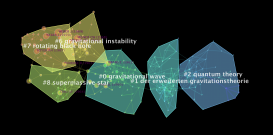Social network analysis (SNA) allows for the identification of relevant actors in complex, interlinked social settings. Recent extensions of this approach to multi-level and multiplex networks enable research on the interconnection of social networks with other network structures such as institutions and concepts. The dynamics that lead to the formation and diffusion processes of these networks can be researched with such methods as Exponential Random Graph Models (ERGM), models based on the concept of random walker, and so-called Map-Equation (infomap) and actor-oriented models as implemented in RSiena. For this project, data describing the cooperation and advice structures of the main actors working in the field of general relativity from 1920 to 1980 were gathered manually by reading the sources. The data were then carefully checked and entered into a database. It was subsequently transformed into RDF-based graph data, which can be exported into different formats suitable for network analysis.

Development of the betweenness centrality for the most relevant persons.
As a first step for the analysis, these graph data produce a visual analysis of the network for each year. Application of SNA and ERGM gives more information about the actual structures of the network. The results so far show structural changes in the expected time periods after the 1960s and structural changes of the networks during World War II. The outcomes also reveal a need for further analysis of the modes of cooperation within those institutions with which the researchers were affiliated. Variation of the parameters describing the relevance of institutional cooperation versus documented cooperation by means of co-authorship or PhD supervision changes the role of the actors in the network significantly, particularly in the years after 1960. Problems to be solved in this context include the role of institutional memory for knowledge transfer within an institution and the weight of different forms of influence and collaboration. Ongoing research compares the structures of co-citations and co-authorship, as these can be retrieved from bibliographic databases with the findings based on the manual analysis of sources.

Analysis of the co-citation network using CiteSpace.

